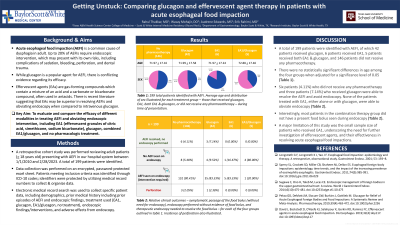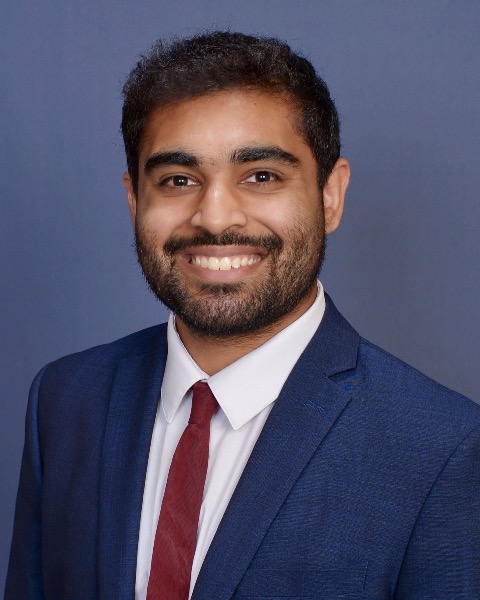Tuesday Poster Session
Category: Esophagus
P3232 - Getting Unstuck: Comparing Glucagon and Effervescent Agent Therapy in Patients With Acute Esophageal Food Impaction
Tuesday, October 24, 2023
10:30 AM - 4:00 PM PT
Location: Exhibit Hall

Has Audio

Rahul R. Thakkar, MD
Baylor Scott & White Health
Round Rock, TX
Presenting Author(s)
Rahul R. Thakkar, MD1, Wasay A. Mohajir, DO2, Erik F. Rahimi, MD2
1Baylor Scott & White Health, Round Rock, TX; 2Baylor Scott & White, Round Rock, TX
Introduction: Acute esophageal food impaction (AEFI) is a common cause of dysphagia in adults. Up to 20% of patients with AEFI require endoscopic intervention, introducing risks such as perforation. Therefore, there is an interest in improving conservative measures to resolve AEFIs while minimizing or even obviating endoscopic intervention. While glucagon is a popular agent for AEFI, there is conflicting evidence regarding its efficacy in resolving AEFI. Effervescent agents (EAs) are gas-forming compounds which contain a mixture of an acid and a carbonate or bicarbonate compound and are used in antacids. There is recent literature suggesting that EAs may be superior in resolving AEFIs compared to intravenous glucagon, while avoiding endoscopy. This study aims to evaluate and compare the efficacy of different modalities in treating AEFI including EA1 (effervescent granules of citric acid, simethicone, sodium bicarbonate), glucagon, combined EA1/glucagon, and no pharmacologic treatment while minimizing endoscopic therapy.
Methods: A retrospective cohort study was performed reviewing adult patients presenting with AEFI in our hospital system between 1/1/2010 and 2/28/2023. In addition to patient demographics and pertinent medical history, information was obtained on the received treatment (no pharmacotherapy, intravenous or intramuscular glucagon, EA1, both EA1 and glucagon), endoscopic interventions (if performed), and adverse events including perforation.
Results: A total of 199 patients were identified with AEFI, of which 42 patients received glucagon, 6 patients received EA1, 5 patients received EA1/glucagon, and 146 patients did not receive either treatment (Table 1). Three patients (7.14%) in the glucagon group and 6 patients (4.11%) in the no pharmacotherapy group were able to resolve the AEFI without endoscopy. All patients treated with EA1 alone and with glucagon subsequently underwent endoscopy; however, most patients in the combination therapy group did not have a present food bolus and thus did not require any further intervention. Four of the total 190 endoscopies performed were complicated by perforation.
Discussion: Further investigation is needed to establish the efficacy of EAs in the treatment of AEFI. While these agents did not eliminate the need for endoscopy, they showed potential in minimizing interventions when combined with glucagon. A major limitation was the small sample size of patients who received EA1, underscoring the need for additional research on their effectiveness.
Disclosures:
Rahul R. Thakkar, MD1, Wasay A. Mohajir, DO2, Erik F. Rahimi, MD2. P3232 - Getting Unstuck: Comparing Glucagon and Effervescent Agent Therapy in Patients With Acute Esophageal Food Impaction, ACG 2023 Annual Scientific Meeting Abstracts. Vancouver, BC, Canada: American College of Gastroenterology.
1Baylor Scott & White Health, Round Rock, TX; 2Baylor Scott & White, Round Rock, TX
Introduction: Acute esophageal food impaction (AEFI) is a common cause of dysphagia in adults. Up to 20% of patients with AEFI require endoscopic intervention, introducing risks such as perforation. Therefore, there is an interest in improving conservative measures to resolve AEFIs while minimizing or even obviating endoscopic intervention. While glucagon is a popular agent for AEFI, there is conflicting evidence regarding its efficacy in resolving AEFI. Effervescent agents (EAs) are gas-forming compounds which contain a mixture of an acid and a carbonate or bicarbonate compound and are used in antacids. There is recent literature suggesting that EAs may be superior in resolving AEFIs compared to intravenous glucagon, while avoiding endoscopy. This study aims to evaluate and compare the efficacy of different modalities in treating AEFI including EA1 (effervescent granules of citric acid, simethicone, sodium bicarbonate), glucagon, combined EA1/glucagon, and no pharmacologic treatment while minimizing endoscopic therapy.
Methods: A retrospective cohort study was performed reviewing adult patients presenting with AEFI in our hospital system between 1/1/2010 and 2/28/2023. In addition to patient demographics and pertinent medical history, information was obtained on the received treatment (no pharmacotherapy, intravenous or intramuscular glucagon, EA1, both EA1 and glucagon), endoscopic interventions (if performed), and adverse events including perforation.
Results: A total of 199 patients were identified with AEFI, of which 42 patients received glucagon, 6 patients received EA1, 5 patients received EA1/glucagon, and 146 patients did not receive either treatment (Table 1). Three patients (7.14%) in the glucagon group and 6 patients (4.11%) in the no pharmacotherapy group were able to resolve the AEFI without endoscopy. All patients treated with EA1 alone and with glucagon subsequently underwent endoscopy; however, most patients in the combination therapy group did not have a present food bolus and thus did not require any further intervention. Four of the total 190 endoscopies performed were complicated by perforation.
Discussion: Further investigation is needed to establish the efficacy of EAs in the treatment of AEFI. While these agents did not eliminate the need for endoscopy, they showed potential in minimizing interventions when combined with glucagon. A major limitation was the small sample size of patients who received EA1, underscoring the need for additional research on their effectiveness.
Disclosures:
Rahul Thakkar indicated no relevant financial relationships.
Wasay Mohajir indicated no relevant financial relationships.
Erik Rahimi indicated no relevant financial relationships.
Rahul R. Thakkar, MD1, Wasay A. Mohajir, DO2, Erik F. Rahimi, MD2. P3232 - Getting Unstuck: Comparing Glucagon and Effervescent Agent Therapy in Patients With Acute Esophageal Food Impaction, ACG 2023 Annual Scientific Meeting Abstracts. Vancouver, BC, Canada: American College of Gastroenterology.

